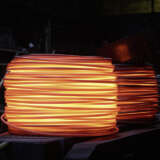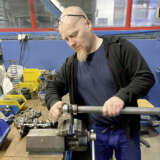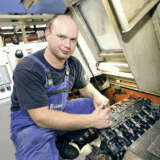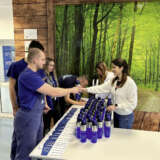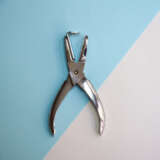Guiding a concept to series production is a long process

It does not always have to be the reinvention of the wheel. In terms of strategy, it can be just as worthwhile for a company to use its own expertise to mirror a competitor’s product. Like we have done with the brake caliper guide pin: our goal is to enter series production with this part within the next year.

One of the vehicles in which the Guide Pin is installed: Mercedes-Benz Sprinter
This fastener can be found wherever there are brakes. Two guide pins per brake caliper direct the caliper into the brake mount that controls the opening and closing of the brake caliper. Our colleagues in Museros are already producing the necessary bolts. And, thanks to the fact that this part will be required in all vehicles – regardless of whether combustion engines or electric motors power them – this is a product with a bright future.
Something that began about two years ago as a project study in collaboration with teams from the Research & Development and Technology divisions and our plant in Homburg is now part of a full-sty development process. And it is approaching the finish line: approvals are currently being obtained from the customer Continental for this product.
“It is the first product that we are once again machining ourselves in Homberg.”
Christoph Haust
Utmost precision
Viewed from the outside, the guide pin is not exactly spectacular. The design reveals its brilliance only on closer examination: the fastener head has an internal thread. The head itself must be straight to ensure that it is flush and can guide the brake caliper as straight as possible. The guide pin shaft also has a subtle indentation for a seal that protects this sensitive part against rust and dirt. The aim is to produce as much as possible by forming, but for the details described, it is necessary to machine due to precision and geometry.
“It is the first product that we are once again machining ourselves in Homberg,” reported Christoph Haust, project manager. To build up this expertise, Homberg is working with teams from the company’s plants in Turnov and Osterode as well as RSW. They are conducting workshops to discuss their problems and working together to find solutions. As their knowledge grows, so does their efficiency. “And this is urgently necessary if we want to be able to produce these parts economically.”
Working together to put the project on the road to success: the Guide Pin team from Homberg
The machining is not the guide pin’s only special feature. There are three spaces on the guide pin located 120 degrees apart. Grease is placed in these recesses to allow the part to mesh with the brake caliper. And finally, it is important that the transition radii on the head be precisely engineered. To do this, it is necessary to have the right measurement technology.
Employing new knowledge for the future
A major advantage: the things we learn here can be transferred to other projects – this is the case for machining, as well as for measurement technology. While bolts and screws are often inspected visually, this is not sufficient for brake caliper guide pins. “Our knowledge regarding the measurement and testing methods of fasteners is profound. However, the established procedures do not fit the challenges of CFPs, which is why you have to take up the subject early in the project,” said Haust. In the future, questions like “What is the best measurement strategy?” and “How does the customer conduct measurements?” will play a role right from the start whenever extreme precision is required.
From machine fitters to development heads, lots of our colleagues are involved – some of them have even taken on responsibilities on top of their normal duties. When it comes to questions about coating, the team is drawing on the expertise of our colleagues at GALOL, in addition to engaging in dialogue with external service providers. Haust: “We are on a tight schedule.”
Something else that’s required: a learning culture. When the first customer test was performed, the guide pin did not deliver the desired performance. KAMAX CEO Jörg Steins put it this way: “It’s good that we know this now, so that we have time to react.” This attitude is essential if we want to grow.
From the ground up
“We are currently doing a great deal, because there is a lot that we need to learn,” admitted Haust. “There are a number of players who have a significant lead over us in development. If we can establish ourselves with this product, however, we will be able to get in on the ground floor of new platforms or vehicle models.”
There is already reason enough for us to pat ourselves on the back: KAMAX already has a confirmed purchase order and will become a serial supplier for Continental after the pending PPAP approval. After all, this brake part is a safety-critical component – few parts are more important. We can be sure that expertise, price, reliability, and quality all had a role to play.
KXpress



